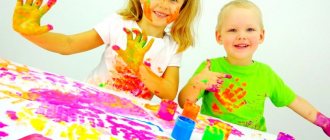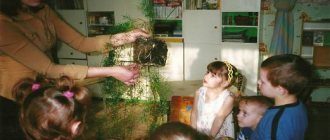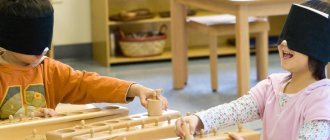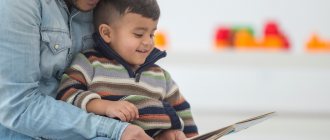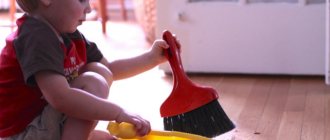Objectives of education and training in the preparatory group
TASKS OF EDUCATION AND TRAINING IN A PREPARATORY GROUP
Continue the comprehensive education and development of children, strengthen their health, and improve physical development. Develop cognitive interests, cultivate sustained attention, observation, develop interest in educational activities and the desire to study at school. Develop the ability to analyze and synthesize, self-control, and self-assessment when performing work. Based on expanding knowledge about the environment, cultivate patriotic and international feelings, love for the native land, the Motherland. To reinforce the idea that people of different nationalities live peacefully in our country. Continue to develop labor skills and abilities, cultivate diligence. Continue to improve all aspects of speech; teach children to use both short and common forms of answer, depending on the nature of the question posed, and to complement the statements of their comrades. Prepare children to learn to read and write. Continue to develop phonemic awareness and speech sound analysis skills. To develop the artistic and creative abilities of children in various types of artistic activities. Develop aesthetic perception, sense of rhythm, aesthetic appreciation, artistic taste, aesthetic attitude towards the environment, art and artistic activity. Continue to develop an interest in classical and folk art (musical, visual arts, literature, architecture). Develop organization, discipline, collectivism, respect for elders, caring attitude towards children, the ability and desire to independently unite for joint play and work, to help each other, evaluate the activities of peers kindly. Continue to develop skills in educational activities: listen carefully to the teacher, act according to the plan he proposes, as well as independently plan your actions, carry out the assigned mental task, and correctly evaluate the results of your activities.
Preparatory group for school (from six to seven years old). Age-related characteristics of children's mental development
In role-playing games, children of the seventh year of life
begin to master complex interactions between people, reflecting characteristic significant life situations, for example, a wedding, the birth of a child, illness, employment, etc.
Game actions become more complex and take on a special meaning that is not always revealed to adults. The playing space is becoming more complex. It can have several centers, each of which supports its own storyline. At the same time, children are able to monitor the behavior of partners throughout the playing space and change their behavior depending on their place in it. Thus, the child already addresses the seller not just as a buyer, but as a buyer-mother or buyer-driver, etc. The performance of a role is emphasized not only by the role itself, but also by the part of the playing space in which this role is played. For example, playing the role of a bus driver, a child commands passengers and obeys the traffic police inspector. If the logic of the game requires the emergence of a new role, then the child can take on a new role during the game, while maintaining the role taken previously. Children can comment on the performance of the role by one or another participant in the game.
Images from surrounding life and literary works conveyed by children in visual activities become more complex. The drawings become more detailed and their color range is enriched. The differences between the drawings of boys and girls become more obvious. Boys willingly depict technology, space, military operations, etc. Girls usually draw female images: princesses, ballerinas, models, etc. Everyday scenes are also common: mother and daughter, room, etc. With the right pedagogical approach Children develop artistic and creative abilities in visual arts.
The image of a person becomes even more detailed and proportional. Fingers, eyes, mouth, nose, eyebrows, chin appear. Clothing can be decorated with various details. Children in the pre-school group have largely mastered construction using building materials. They are fluent in generalized methods of analyzing both images and buildings; not only analyze the main design features of various parts, but also determine their shape based on the similarity with familiar three-dimensional objects. Free buildings become symmetrical and proportional, their construction is carried out on the basis of visual orientation. Children quickly and correctly select the necessary material. They quite accurately imagine the sequence in which the construction will be carried out, and the material that will be needed to complete it; are able to carry out constructions of varying degrees of complexity, both according to their own plans and conditions.
At this age, children can already master complex addition forms from a sheet of paper and invent their own, but they need to be specially taught this. This type of activity is not only accessible to children, it is important for deepening their spatial understanding.
Design from natural materials becomes more complicated. Children already have access to holistic compositions based on a preliminary plan, which can convey complex relationships and include figures of people and animals in various conditions.
Children continue to develop perceptions, but they cannot always take into account several different signs at the same time. Figurative thinking develops, but the reproduction of metric relationships is difficult. This can be easily checked by asking children to reproduce on a piece of paper a sample on which nine dots are drawn that are not located on the same straight line. As a rule, children do not reproduce metric relationships between points: when drawings are superimposed on each other, the points of the child's drawing do not coincide with the points of the sample.
Generalization and reasoning skills continue to develop, but they are still largely limited to visual signs of the situation.
Imagination continues to develop, but it is often necessary to note a decrease in the development of imagination at this age in comparison with the older group. This can be explained by various influences, including the media, leading to stereotypical images of children.
Attention continues to develop, it becomes voluntary. In some activities, voluntary concentration time reaches 30 minutes.
Children continue to develop speech: its sound side, grammatical structure, vocabulary. Coherent speech develops. Children's statements reflect both the expanding vocabulary and the nature of generalizations that are formed at this age. Children begin to actively use generalizing nouns, synonyms, antonyms, adjectives, etc. As a result of properly organized educational work, children develop dialogic and some types of monologue speech.
In the preschool group, preschool age ends. His main achievements are related to the mastery of the world of things as objects of human culture; children master forms of positive communication with people; Gender identification develops and the student’s position is formed.
By the end of preschool age, the child has a high level of cognitive and personal development, which allows him to successfully study at school in the future.
MAGAZINE Preschooler.RF
PERSPECTIVE PLANNING TAKEN INTO ACCOUNT OF THE FSES IN THE PREPARATORY GROUP.Winner of the all-Russian competition “The most popular article of the month” October 2016
Conditions of the competition:
Authors:
- Taranyuk Maria Vasilievna.
- Evseenko Tamara Ivanovna
Municipal preschool educational institution, a general developmental kindergarten with priority implementation of activities for the artistic and aesthetic development of children No. 109.
Educator. Komsomolsk-on-Amur, Khabarovsk Territory
SEPTEMBER 1 WEEK TOPIC: “MEMORY OF SUMMER”
TASKS: to summarize and systematize children’s knowledge about the characteristic features of summer, about work in nature (in the garden), about summer fun, about the life of the flora and fauna in the summer.
ORGANIZED JOINT EDUCATIONAL ACTIVITIES EDUCATIONAL ACTIVITIES DURING REGULAR MOMENTS
COGNITIVE DEVELOPMENT Cognitive development
Topic: “Memories of Summer”
Etc. tasks: To summarize and systematize the idea of summer according to the main essential features (thunderstorm, rainbow, lightning), about the characteristics of the life of animals in the forest, to clarify the idea of certain types of agricultural labor in the summer; develop the ability to establish a connection between a set of conditions (heat, light, moisture and plant condition); cultivate a desire to share your knowledge and memories with peers.
Mathematics
Etc. tasks: Practice counting within 10; assign numbers from 0 to 10; ordinal counting; practice comparing objects by length and width; repeat the composition of the number; learn to answer in sentences, use plural nouns correctly; develop the ability to understand and independently perform a given task; cultivate endurance.
Pomerantseva str. 14 No. 1, No. 2
Search and research activities.
Topic: "Water Filtration" .
Etc. tasks: to introduce children to the processes of water purification in different ways (sand, rag, blotting paper"; Develop reasoning skills, establish cause-and-effect relationships. Foster a caring attitude towards water.
- D/i “Insects” - to consolidate children’s knowledge about insects, the structure of their body, benefits for humans, nature.
- D/i “When does this happen?” - develop observation skills.
-D/i “Seasons” - teach to see signs of seasonal changes in the weather, plants, animal behavior, life and work of people.
— D/i “Bees and Flowers” — develop attentiveness and interest in nature.
— Lotto “Wildlife” — teach to distinguish different types of plants.
-Butterfly watching
— D/n “Numbers” — repeat numbers from 0 to 10.
- D/i “Similar - not similar” - exercise in comparing objects by shape, color, size.
Regional component
Topic: “Plants of the Khabarovsk Territory” - introduce rose hips, note that in the Far East it is called “Daurian Rose” , cultivate interest in the flora of the Far East.
Experimental activities
“Smell, taste, touch, listen” - to consolidate children’s ideas about the senses, their purpose (ears - to hear, recognize various sounds; nose - to detect smell; fingers - to determine the shape, structure of the surface; tongue - to determine taste).
| Next > |
Article:
Goals: expanding contact between teachers and parents;
modeling prospects for interaction for the new academic year; improving the pedagogical culture of parents. Objectives: consider the age and individual characteristics of children 6-7 years old; introduce parents to the tasks and features of educational work, the tasks of the preschool institution for the new school year.
Form of delivery: presentation
Age 6 - 7 years
Senior preschool age is a period of learning about the world of human relationships, creativity and preparation for the next, completely new stage in his life - studying at school.
Play activity
In role-playing games, children in the preschool group begin to master complex human interactions. Reflecting characteristic life situations. Game actions become more complex and take on a special meaning that is not always revealed to adults. The playing space is becoming more complex. When organizing joint games, children use an agreement, are able to take into account the interests of others, and to some extent restrain emotional impulses.
There is a gradual transition from play as a leading activity to learning.
Construction
Children in the pre-school group have largely mastered construction using building materials.
At this age, children can already master complex addition forms from a sheet of paper and invent their own, but they need to be specially taught this. This type of activity is not only accessible to children, it is important for deepening their spatial understanding. Design from natural materials becomes more complicated.
Visual activities
Images from surrounding life and literary works conveyed by children in visual activities become more complex. The drawings become more detailed and their color range is enriched.
The differences between the drawings of boys and girls become more obvious. Boys willingly depict technology, space, military operations, etc. Girls usually draw female images: princesses, ballerinas, models, etc. Everyday scenes are also common: mother and daughter, room, etc. The image of a person becomes even more detailed and proportional. Fingers, eyes, mouth, nose, eyebrows, chin appear. Clothing can be decorated with various details.
One of the most important features of this age is the manifestation of arbitrariness of all mental processes. (When the child begins to consciously direct and hold on certain objects and objects.)
Development of mental processes
Children continue to develop perceptions, but they cannot always take into account several different signs at the same time. (Size, shape of objects, position in space)
Imagination continues to develop, but it is often necessary to note a decrease in the development of imagination at this age in comparison with the older group. This can be explained by various influences, including the media, leading to stereotypical images of children.
Thinking
Thinking at this age is characterized by a transition from visual-effective to visual-figurative and at the end of the period - to verbal thinking.
1) visual-effective (cognition through the manipulation of objects) (for example, he takes out an object that lies high, placing a chair)
2) visual-figurative (cognition through representations of objects, phenomena, without the use of practical actions.) (eg, can assemble cubes, light puzzles without relying on visualization)
3) verbal-logical (cognition with the help of concepts, words, reasoning, which is associated with the use and transformation of concepts). (eg, can post 6-7 pictures in a row, logically connected to each other).
Children are able not only to solve a problem visually, but also to make transformations of an object, indicate in what sequence the objects will interact, etc.
A preschooler thinks figuratively, but has not yet acquired adult logic of reasoning. The prerequisites for such mental qualities as independence, flexibility and inquisitiveness are being formed. There are attempts to explain phenomena and processes. Children's questions are indicators of the development of curiosity.
Attention becomes voluntary.
At this age, concentration, volume and stability of attention increase significantly, elements of arbitrariness in the management of attention are formed based on the development of speech and cognitive interests.
In some activities, voluntary concentration time reaches 30 minutes. The stability of attention increases - 20-25 minutes, the volume of attention is 7-8 objects. The child may see dual images.
Memory
At 6-7 years of age, memory capacity increases, which allows children to involuntarily remember a fairly large amount of information. Children can independently set themselves the task of remembering something. Using the simplest mechanical method of memorization - repetition.
Speech
The sound aspect, grammatical structure, and vocabulary are developing. Coherent speech develops.
Children's statements reflect both an expanding vocabulary and the nature of sensations that form at this age. Children begin to actively use generalizing nouns, synonyms, antonyms, adjectives, etc.
Dialogue and some types of monologue speech develop. Relationships with peers. Children of senior preschool age are characterized by a predominance of socially significant motives over personal ones. A child can change his point of view, positions as a result of a collision with public opinion, the opinion of another child. The child can perceive the point of view of another person. In the process of assimilation, an active attitude towards one’s own life develops empathy and compassion.
Emotions
The child has developed a stable positive attitude towards himself and confidence in his abilities. He is able to show emotionality and independence in solving social and everyday problems. A critical attitude to the assessment of adults and peers arises. Peer assessment helps the child evaluate himself.
- The child judges moral qualities mainly by his behavior, which either agrees with the norms accepted in the family and peer group, or does not fit into the system of these relations.
- The self-esteem of a child of senior preschool age is quite adequate; it is more typical to overestimate it than to underestimate it. The child evaluates the result of an activity more objectively than behavior.
- As the most important new formation in the development of the mental and personal sphere of a child of 6–7 years of age, the subordination of motives is.
- Awareness of the motive “I must”, “I can” gradually begins to prevail over the motive “I want”.
- In the preschool group, preschool age ends.
- His main achievements are related to the mastery of the world of things as objects of human culture; mastering forms of positive communication with people; development of gender identification, formation of the student’s position.
- By the end of preschool age, the child has a high level of cognitive and personal development, which allows him to successfully study at school in the future.
- A child can and does do not what he wants, but what is needed, what an adult asks or is determined by the rules: he perceives, remembers, thinks, evaluates his activities;
- The first real picture of the world appears, about which the child forms his own opinion;
- The child begins to understand his feelings and experiences fully and communicates this to adults;
- It is very important for children how the people around them treat them;
- There is complete trust in the adult and acceptance of his point of view. Treating adults as the only source of reliable knowledge.
Children 6-7 years old should be able to:
- Distinguish geometric shapes, highlight them in objects of the surrounding world
- Characterize the spatial relationships of objects (right-left, above-under, on-behind, top-bottom, etc.)
- Distinguish the spatial arrangement of figures and parts on a plane
- Classify shapes by shape, size, color
- Distinguish and highlight letters and numbers by shape, size, color
- Mentally find a part of the whole
- Complete the figures according to the diagram, construct them from parts
- Speech.
- Correctly pronounce all the sounds of your native language
- Be able to distinguish and name words with a certain sound
- Be able to determine the place of a sound in a word (beginning–middle–end)
- Divide words into syllables
- Compose words from syllables
- Have an idea of the offer
- Be able to agree words in gender, number and case
- Select synonyms, antonyms
- Use different ways to form words
- Retell familiar fairy tales and stories
- Compose stories and fairy tales based on pictures
- Gross motor skills
- Walk, run, jump straight and firmly
- Accurately catch and throw the ball
- For some time wearing not very light things, large objects
- Fasten buttons, tie shoelaces, etc.
- Fine motor skills
- Draw straight, not shaky lines
- “See the line” and write in it
- See the cells and accurately draw along them
- Educational targets at the stage of completion of preschool age:
- these are social-normative age characteristics of a child’s possible achievements at the stage of completing preschool education.
- They assume the formation of prerequisites for educational activities in preschool children at the stage of completing their preschool education.
- They act as the basis for the continuity of preschool and primary general education.
Top advice for parents
- Be attentive to your child, love him, but do not “tie” him to you, let him have friends, his own social circle. Be prepared to support your child, listen and encourage him. The key to success is friendly and open relationships in the family. It is easier to cope with a problem when it has just arisen and has not yet led to negative consequences.
- Encourage interaction with peers
- Teach your child to manage emotions (using the example of your behavior)
- It is necessary to prepare the child for school in advance (educational games, poetry).
- There is no need to overload with additional activities.
- Praise more.
